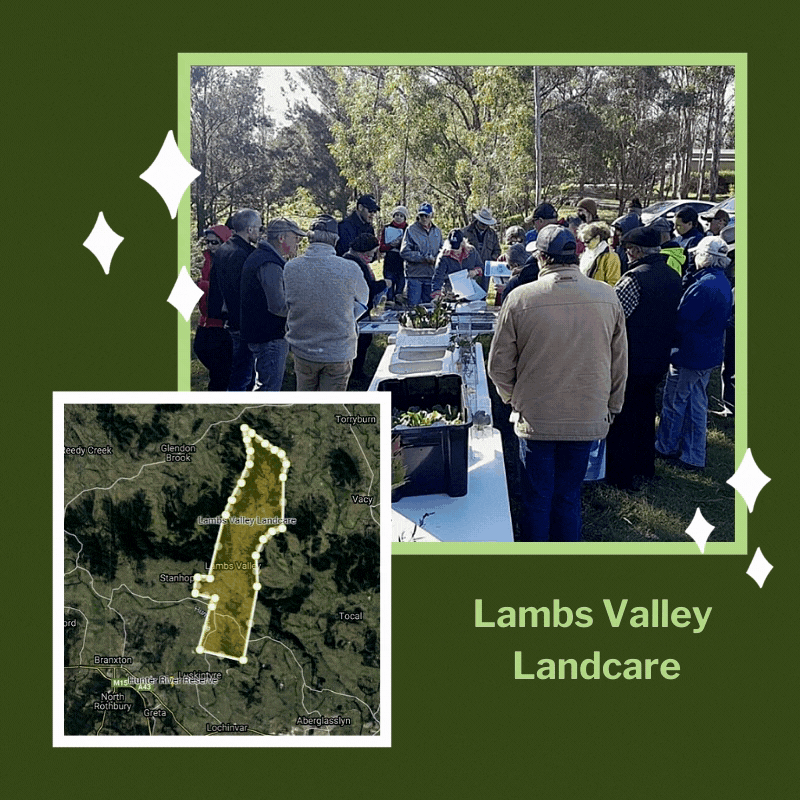1993 – Present
Lambs Valley Landcare was formed in 1993 with 28 members. At the time the Lambs Valley community only consisted of approximately 35 members. One of the very early activities was the completion of a Catchment Management Plan with the assistance of the then Department of Land and Water Conservation.
Lambs Valley Catchment is located in the southeast corner of the Singleton Shire local government area (LGA) and includes approximately 5,500 hectares of the Singleton Shire LGA. Lambs Valley is heritage listed with Maitland Council. The catchment plan area covers approximately 66.7 km². The catchment consists of a wide low-lying valley floor which only rises sharply at the base of the boundaries formed the eastern and western ranges.
The major llandusage in previous years was both dairy farming and timber production. However it has become much more diversified with beef production, goat and alpaca farming, grape and olive growing, bush food plantations, and horse studs.
Big Wins
Field days focusing on terrestrial and water weeds and their control, a native grasses recognition workshop.
Lessons
The value of a catchment approach cannot be underestimated.
One of the major benefits of the catchment plan to landholders has been highlighting the landuse physical and legal constraints when making management decisions for their property. These physical constraints revolve around landuse capability while the legal constraints are governed by various government acts of parliament.
The expertise and knowledge contained within the catchment plan has facilitated and provided a framework for the community and land holders/managers to learn formally and informally of the many land management issues that exist in most local catchments. Another very tangible outcome and the value of a catchment approach to management lies in an understanding of the interaction between all different components of the environment.
Being a rural Landcare group has meant most activities have occurred on private properties. Unfortunately there is little community land within the catchment and therefore limited opportunity for the Landcare group to come together to participate in addressing community land issues. However, like most rural areas, roadside weeds are becoming a major problem, particularly with introduced grass weeds such as African love grass and Coolatai grass. African olive is also becoming a major problem in the Hunter Valley. These weeds provide a community focus for the group with annual spraying programs. Another very successful community project was the rehabilitation of a disused gravel quarry.
In addition the members of the group have participated in assisting each other in their Landcare activities. Many of these activities have involved addressing riparian degradation. Lambs Creek is a prescribed stream and a tributary to the Hunter River. Like most rural waterways the creek served as a watering point for cattle for many years with the attendant erosion, poor water quality and lack of native vegetation. Landholders, after learning of the many ecosystem services that these water bodies provide, went about erecting livestock fencing and revegetating the riparian zones. These activities have brought about transformational appearance, nature, and health of the creek system and provided demonstration sites where local landholders and visitors can see on-ground works and results of good river management.
Lambs Valley Landcare group have hosted quite a number field days providing valuable natural resource management information to landholders from throughout the region. These include, field days focusing on terrestrial and water weeds and their control, a native grasses recognition workshop, and the importance of soils in farming and knowing how to get help with soil management and analysis from Local Land Services and the Department of Agriculture and finally, understanding the importance of native vegetation to riparian protection, knowledge of the species to use in riparian restoration and understanding of creek dynamics.
Having a comprehensive Catchment Management Plan has enabled the group to source valuable funds from various funding bodies including the Hunter Catchment Management Trust (now Local Land Services) and the NSW government’s Envirotrust and the gederal government’s Caring for our Country program. These have been invaluable funds to carry out programs which can be very expensive for private landholders. The completion of an African olive and lantana weed control program throughout the Valley was one such program.
The value of a catchment approach cannot be underestimated. It’s difficult to think of any action that could take place at the top of a catchment and not have the potential to influence the environment downstream. All the major environmental problems like declining water quality, dryland salinity and soil erosion are clearly linked to something happening in another part of the catchment. Accordingly, we must manage our land, water and vegetation on a catchment basis – no matter what size the catchment. A Total Catchment Management approach recognises the integrated, complex and dynamic nature of catchments where the land, water, and vegetation fit together to form a complete picture. A catchment approach also encourages people to think more broadly and look beyond their own farm gate or back fence.




